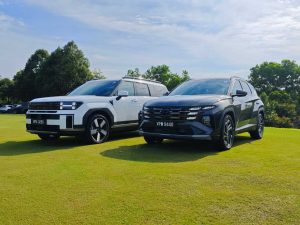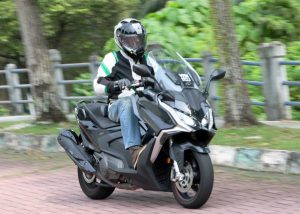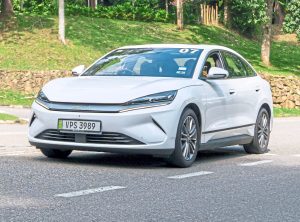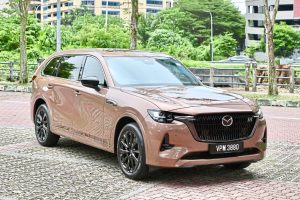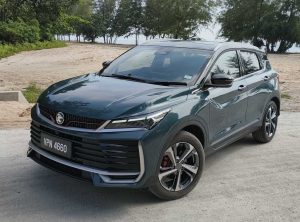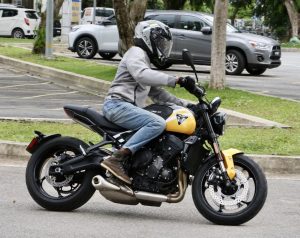Mention Stellantis and chances are that the name may not strike a chord with many Malaysians.
Locals here are likely to be better acquainted with names like Peugeot, Citroen or Maserati although they could be unaware that these brands are in the Stellantis automotive group.
Stellantis chief operating officer (Asean and General Distributors) Daniel Gonzalez knows this perception and said the group is young but has 14 automotive brands with long legacies and rich history.
“Stellantis is the mothership. As our CEO Carlos Tavares says, Stellantis is a three-year-old baby.
“With Stellantis as the house, we have all the possibilities to start with Peugeot and bring the other brands along to provide solutions for other segments of the Malaysian automotive industry,” Gonzalez, who hails from Venezuela, said in an interview. He was appointed to the position in March.

Gonzalez with the Peugeot E-2008 which will be launched in Malaysia next year.
Stellantis, which was formed in 2021 through the merger of the PSA Group and Fiat Chrysler Automobiles (FCA), is one of the world’s largest automakers.
Among its brands that should be familiar to Malaysian motorists are Alfa Romeo, Fiat, Jeep and Opel.
Stellantis has set its eyes on Asean which it sees as part of its “third engine” combined with South America, and the Middle East and Africa.
The group acquired 100% ownership of the Gurun automotive factory in 2021 and has set up its India and Asia Pacific Regional Headquarters in Kuala Lumpur which also highlights its “Built in Asean for Asean” strategy.
“Asean is a market that can only grow,” he said.
Gonzalez said Stellantis is entering Malaysia with sizeable investments that could create opportunities worth up to RM5bil for local businesses in the manufacturing and outsourcing sectors among others.
“We have set up our regional headquarters in Kuala Lumpur to better run operations as ‘remote control’ from somewhere else doesn’t work.
“If you want to grow in the region, we need to localise production and run things from location.
“We need to be here with local talents and we are on a recruitment spree. I have been having conversations with the government and other entities about future business.
“Stellantis will be here for the long run and not an in-and-out thing. We want to fully utilise our Gurun plant,” he said.

Gonzalez.
The roadmap also sees great potential in turning Malaysia into a regional hub for mobility solutions with an emphasis on electrification such as battery electric vehicles (BEV) as well as EV battery production and the setting up of a regional training academy.
Other possible partnerships with local companies can also be in areas of charging infrastructure, battery technology, software development and transportation services.
The Gurun plant in Kedah is now producing Peugeot 2008, 3008 and 5008 models for Malaysia and regional markets such as the Philippines, Thailand and Cambodia.
Among the innovative products that Stellantis is considering bringing to Malaysia is the newly developed STLA Medium platform which is a modular by-design battery electric vehicle (BEV) platform which delivers high energy efficiency and a best-in-class driving range of 700km.
Its flexible wheelbase enables the production of C- and D-segment vehicles in various body styles of passenger cars, crossovers and SUVs.
STLA Medium is also a multi-energy platform which means it can also be used to produce internal combustion engine (ICE) and mild hybrid electric vehicles (MHEV).
Stellantis is investing over RM2bil in the STLA Medium platform which is part of the automotive group’s long-term commitment to sustainability and achieving the ambitions of its Dare Forward 2030 strategy.

Peugeot 408.
Gonzalez said although Stellantis has a strong commitment towards electrification, the group would continue to support regions that still relied on ICE cars with the latest clean technology.
“The adoption of BEVs in North America and Europe is more legislation-driven than market-driven,” he said.
Malaysia, among other places that are not compelled by law to adopt EVs on a large scale, is still highly dependent on ICE cars.
“As such, we must continue to support them with R&D on ICE,” he said, adding that ICE cars would still be around for some time.
“We want to be at the forefront of BEVs as it’s the newly accepted technology that we have committed to.
“And we have also always talked about mobility solutions because it encompasses everything.
“But if tomorrow’s mobility is mild hybrid or ICE, we will still be at the forefront.
“Betting our chips on one thing or one technology that we don’t know a lot of can be dangerous not only to the organisation but also our customers.
“There is a lot to learn and we have to be humble,” he said.
Gonzalez also said popular car models in Malaysia are from the B- and C-segments with some from the D-segment that suit the STLA Medium platform.
“Within STLA Medium, we will have the availability of several types of vehicles including the next generation 3008 and 5008,” he said.
On the national car brands dominating the entry-level car market, Gonzalez said Proton and Perodua have done a good job with their cars.
“But we never stop analysing and looking at things.
“If we see an opportunity, we will take it.
“In the short-term, our cars are tailored to the M40 and the T20 buyers,” Gonzalez added.
StarCarSifu: Do you plan to introduce other brands under Stellantis to the Malaysian market besides Peugeot?
Gonzalez: We have a beautiful menu of cars that you will like. Personally, I see Jeep or Citroen arriving. I certainly get a lot of requests for Alfa Romeo wherever I go. I have also gotten some comments on Fiat. And there is also the possibility of Ram, our main pick-up truck brand. In the Asean region, we have nine out of our 14 brands. In the future, our focus will be on the localised production.
But there will be space for niche segments. When we opened our Alfa Romeo showroom in Singapore two months ago, more than half of the guests were from Malaysia and they asked me when Malaysia will be getting Alfa Romeo cars. (laughs)
What do you want the Stellantis brand to be associated with?
I want our customers to connect Stellantis with emotion, especially to each of the brands. For Peugeot, we are talking about allure and drive experience. And when we talk about Jeep, its DNA is freedom and adventure. And Ram is the pick-up built for toughness. What we want is for people to connect more to the brands under Stellantis.
Will Stellantis be only offering passenger cars in Asean?
In Europe, we are very strong in our e-light commercial vehicle (LCV) business with our line-up combination of Peugeot, Citroen, Opel and Fiat. Our LCVs already have a presence in Singapore and Taiwan but their markets are small. Malaysia and Indonesia are the markets we want to go into as they are stronger.
We will also launch our built-in-Malaysia Peugeot Landtrek pick-up with upgraded suspension next year as it was earlier introduced as an imported vehicle to test the market. We will have altogether six products that are localised next year.
What are your plans for Peugeot?
In 2024, we will have three major launches of CKD vehicles from the Gurun plant with potentially some sprinkled CBU vehicles. We will launch our all-new Peugeot 408 which is already available in Europe and recently introduced in Vietnam. The 408 is a significantly nicer car. There will also be the E-2008, coming in the middle of next year.
We will like to see more experiential activities for the Peugeot brand. I think this what I understand will resonate better with Malaysian customers who prefer to have their hands on the wheel and see what the cars are like in person. We want to take this energy and elevate the awareness and presence we have in Malaysia.
STELLANTIS FACTS
Who is Stellantis?
Stellantis is a leading global automaker, formed on Jan 16, 2021, with the coming together of PSA Group and Fiat Chrysler Automobiles (FCA).
How big is Stellantis?
Stellantis is one of the largest automakers in the world, with industrial operations in 30 countries and a commercial presence in more than 130 markets.
How many employees work at Stellantis?
Stellantis has over 300,000 employees globally, with the business operations spread across six regions – North America, South America, Europe, China, and importantly India and Asia Pacific.
What are the 14 brands in Stellantis?
The brands are Peugeot, Citroen, DS, Maserati, Abarth, Alfa Romeo, Chrysler, Dodge, Fiat, Jeep, Lancia, Opel, Ram and Vauxhall.
What does electrification look like at Stellantis?
The Stellantis ambition is to be the frontrunner in automotive efficiency.
At EV Day in July 2021, Stellantis revealed plans to invest more than 30 billion euros (RM149.7bil) through 2025 in electrification and software.
All 14 brands are committed to offering best-in-class fully electrified solutions that meet the demands of customers, with ranges of 482km-504km, with class-leading fast charging capability of 32km per minute.
As outlined in the Stellantis strategic plan, Dare Forward 2030, the group is committed to reaching carbon net zero emissions by 2038 globally.
Stellantis has plans to have more than 75 BEV models and achieve global annual BEV sales of five million vehicles by 2030.

